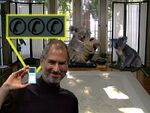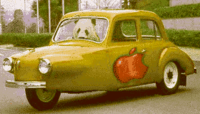Ding-Batch
☝ This article is about the programming language "Ding-Batch". Click here if you were looking for "WTF" instead. Optionally, consider asking this guy about directions.
| User:Tilde/Templates:Fatally Annoying IT | |
| Ding-Batch is an object-oriented programming language for Windows 95, originally developed by Steve Jobs for the ESR operating system using the traditional Wing Ding font found in Chinese Koans. It was later heavily modified by Alan Turing to fit on commercial storage media for Personal Computers such as Minidiscs and donkey meat sheets. | |
A Brief History of Ding-Batch[edit]
Ding-Batch is based on earlier works on magnetism and quantum theory and was designed to compute all problems that are not AAAAAAAAA-complete. As rumor has it, Steve Jobs wanted a language "so easy that it can be programmed by my eMule blindfoldedly and with its hoofs tied behind the neck"; he surprised his coworkers by bringing it to the lab for beta testing.
While not confirmed, this would equate other cases (such as Mac OS X and the iRaq) where he affirmatively did just that. The first version of Ding-Batch was released in early 1824 for the Timex Sinclair on 115 sheets of donkey meat which were deployed by Apple's famous three-wheeled yellow vans driven by Panda bears as a marketing gag.
Introduction and Sample Programs[edit]
By convention, every line of Ding-Batch sourcecode starts with an "@" character.
Ding-Batch Fundamentals: "Ding" and "Batch"[edit]
The fundamental datastructures of Ding-Batch are the "Ding", "✆" and the "Batch", "≈". Which of those is used to represent a given entity is determined by what that entity is not:
- A duck is not a "batch", thus it is a "ding" which is written as:
@✆
- A ham-sandwich is not a "ding", thus it is a "batch" which is written as:
@≈
etc..
Program Flow[edit]
A "program flow" is denoted by enclosing a valid statement in "←" and "→". This leaves us with
@←✆≈→
as shortest valid Ding-Batch program.
Allowed Substitutions[edit]

Programs in Ding-Batch are derived from other programs in Ding-Batch (but see EDB below). The following two operations are allowed:
For example, the next two programs are valid, too (because they have been derived using only the operations above):
@←≈→✆→✆→
(counting all Koala bears in a Zen-monastery)
@→←←←←←←←←←, ≈→✆ ←→✆→ @→✆←!!!!
(caculating the Russian reversal of the above)
Program Storage and Execution[edit]
If saved as a file named "ding.bat" on a computer running Windows 95, the system will execute the file automatically on double-click, by pressing the Any Key or using the Speech-to-Text-command "FNORD".
"Extended Ding-Batch", (EDB)[edit]
In 1848, British mathemagician Oscar Wilde proposed an extended form of Ding-Batch where the Copy&Paste operation would be legitimate from arbitrary sources, thus making the following a valid Extended Ding-Batch program:
@OOF OGD @FOO
(computing the square-sum of god).
For its ease of use and powerful capabilities, Extended Ding-Batch is widely regarded a strong competitor of similar languages, such as Java and Voltran.
See Also[edit]
- Windows 95
- Mac OS X
- Comic Sans - A free implementation of Wing Ding
Sources[edit]
- Donald Hawking, 1825: "A Brief History of Programming", Princeton University Press, 3rd edition.
- Ronald McDonald, 1827: "Turning Turing to Turnaround", Addison-Wesley
On the Web[edit]
- http://www.yahoo.cn - Portal to the Ding-Batch programming language (funded by the Chinese government)
